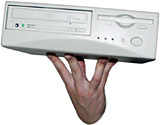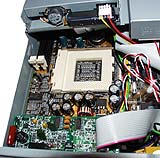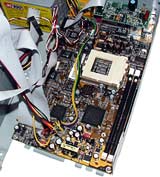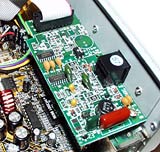
PC Chips Book PC
Review date: April 3 2000.Last modified 03-Dec-2011.
"Basic PC" is seen by a lot of people as a euphemism, like "characterful period residence" or "classic vehicle". It's a marketing term intended to encourage people to buy things which they might not consider if the things were more honestly described. As, for instance, a "creaking, rotten flophouse" or "rust-bug habitat".
The suspiciously cheap "basic PCs" peddled on late-night TV - by people who may or may not also have a nice line of fat-burning herbal teas and pyramid-power lottery number generators - may be perfectly good value. They may also be recycled, refitted Pentium-class machines which can chug along just fine if you just want to run Microsoft Works, play DOOM and surf the Web a bit, but which choke hideously on anything more demanding.
A proper Basic PC is not a cheap machine; it's a simple one. Sure, it'll be cheaper than a power box with a recently released processor, vast hard drive, tons of RAM, high-zoot video card and so on, but this kind of Basic PC still won't be under $AU1000.
The idea is to give the customer all of the bits they need, in one neat little package, ready to rock and roll without any extra configuring or fooling around. Expansion capabilities will be small to nonexistent, but most users won't need to expand the machine; when a lot of home users upgrade their computer, they change enough stuff that they might as well buy a whole new PC anyway.
And if the Basic PC can come in a physically small package, so much the better; the ability to fit the main box in a good-sized briefcase is a selling point for quite a lot of business and home users.
Enter the Book PC.

Tiny, isn't it?
(I keep a disembodied hand in a box for photo shoots such as this.)
The Book PC's name is a bit optimistic, unless you're comparing it with a phone book. It's about 270mm wide, 300mm deep and 80mm high - 10.75 by 12 by 3.25 inches. But it's still dwarfed by this simple desktop case (an In Win D500 microATX unit, mentioned on my page here).
You get a couple of sturdy clip-together side feet with the Book PC, so you can use it in tower configuration; set up like this, it takes up even less desk space.
When you consider that this thing is, for most intents and purposes, a full-function PC, it's really small. At a glance, you'd think it was a diskless workstation or WinCE machine. But this has pretty much everything you want from a desktop PC built in, including networking and an internal modem, and there's TV video output as well.
This is not a cut-down "network PC", incapable of doing anything unless it's hooked up to some big fat server. It's not a specialised Windows CE machine, either - one of the almost-PCs that look like natty baby desktop boxes but actually have the limitations of notebook machines. It's a proper computer. It's a proper computer with no expansion capabilities to speak of, granted, but it's a proper PC. You can run Microsoft Office on it; you can play Quake III on it.
It's got an Intel i810-based motherboard, which like other 810-series boards (for instance, reviewed in the same article as the In Win case) has video and sound hardware built in, and also includes a network adapter. It's not the Intel network adapter that comes on most similarly equipped i810 boards, though; it's a Davicom one, which can cause some confusion with non-Windows operating systems.
The plain i810 chipset used in the Book PC works only with Celeron processors, not the newer FC-PGA Pentium III and Celeron II Socket 370 CPUs. This matches the Basic PC design well; Celerons are excellent value for money, and the faster ones give an excellent account of themselves, with two thirds of the speed of P-IIIs that cost twice as much.
The video adapter's not a lot faster than an old 3dfx Voodoo 2 for 3D, but it can handle 32 bit colour and higher resolutions, if you don't mind losing frame rate. It's fine for games in 800 by 600, and its 2D performance is more than good enough, even at high resolutions on huge monitors.
The basic package includes floppy and CD-ROM drives, plus the motherboard with all of its built-in stuff, and sells for $AU449, to anybody who's happy to add their own hard drive, RAM and CPU. If you'd rather have one with a DVD-ROM drive - not a bad idea, given the built-in video out - that's $AU575.
If you're installing Windows 95 or 98 on the machine, 64Mb of RAM will be adequate, but 128Mb will be better. Windows NT or 2000 needs 128Mb at least. Linux - see the sidebar to the right - isn't fussy.
You won't get away for much less than that, for a full Book PC-based computer. If you can find a slower Celeron then you can save some money there, and you can of course use any spare monitor you've got kicking around. But you won't save an much money over building the same thing in an ordinary case.
A regular PC with an i810 motherboard, microATX case and all the same features will cost you just about exactly the same money; if you go with a normal motherboard that doesn't have video and sound built in, then you'll find yourself paying a bit more, but getting considerably more flexibility.
The Book PC isn't aimed at rabid bargain hunters, though. It's aimed at people who want a simple, elegant and, above all, small basic computer. No PC is really a plug-and-go proposition, but the Book PC comes close.
Hooking up
The little back panel's well supplied with connectors.
From left to right, there's a pair of PS/2 connectors for keyboard and mouse, a couple of USB root hub ports, the 10BaseT/100BaseT RJ45 network connector, and a standard RJ11 phone cable connector for the built-in modem. You get a phone cable, as well as a standard power cable, with the Book PC.
The parallel port's above the three video outputs - a standard 15 pin D-sub connector for a monitor, and both composite and Y/C connectors for TV output (see my video guide here if you're wondering what the difference is).
Next, there's a standard joystick port, and under it are the sound connectors. The sound hardware's your basic stereo set-up, with microphone and line inputs, and a single headphone/speaker output.
The only thing that's missing is serial ports. The Book PC has none. This is fair enough, for most users; modern Wintel PCs don't have much use for serial ports if they've got an internal modem. USB or PS/2 does a better job for mouse connections, since the PC hardware samples serial mouses at a jerky and annoying 33Hz (33 samples per second), and can't be sped up. PS/2 and USB mouses are much smoother.
There are also, of course, no expansion card openings in the back panel, because there are no expansion card slots inside. What you see is pretty much what you get.
Software
There's one CD-ROM and one floppy disk in the Book PC package. The floppy contains DOS drivers for the CD-ROM drive - they can be surprisingly hard to find these days, but aren't actually likely to be needed - and the installer for CD Xpress 3.10. CD Xpress is a CD-ROM caching program - it copies CD data automatically to the hard drive when the system's idle, and transparently accelerates CD-ROM speed by providing the disk-cached data when the system requests data from the slow CD.
On the CD-ROM, you get Windows drivers for all of the Book PC hardware, plus the PC-cillin 98 anti-virus package, and the Yamaha S-YXG50 software MIDI synthesiser, which uses the CPU to imitate an expensive MIDI module and, with modern CPUs, gives great MIDI music output without slowing the system down very much.
The Book PC does have one oddity - the Davicom network adapter, under Windows 95/98, has a "store and forward" option in its properties panel. What, exactly, this option does I'm not sure, but my best guess is "causes the network connection to not work". Turn the option off, and all is well.
Opening it
If you buy a Book PC ready-built then there's no need to crack the case, but it's easy enough to do if you want to change your drive, RAM or CPU configuration. The box-section case is a solid spot-welded arrangement made of 1mm steel, and it's held on by three standard screws at the back. Take 'em out and you can slide the case off easily.
Once you're inside, though, you also have to remove the drive bays to do just about anything to the computer.
The floppy drive cable fouls the CPU socket release lever, and the CD-ROM drive fouls the CPU fan connector on the motherboard; the RAM slots are almost completely under the floppy bay.
You only need to undo a couple more screws to free the drive bays, though.
It's all built about as well as most cheap cases, but the edges aren't razor sharp and the small scale of the thing means it's very sturdy. You're not likely to spend much time fiddling with a Book PC's guts, in any case, since there's really not much you can do.
Mounting drives and installing RAM and a CPU is no harder than doing it in a regular case; the hard drive mounts under the CD-ROM, and there are no funny mounting rails or other oddities to deal with.
With the case open, you can see the dainty little Power Supply Unit (PSU), which is perfectly adequate. Many low cost computers come with low-grunt PSUs that are adequate for the base spec machine but can't handle extra expansions; the Book PC isn't going to have any extra expansions, though, so the little PSU is OK.
It's also easy to remove the front bezel; you can unclip it without even opening the case. The importers have some see-through iMac-esque bezels on the way, for them as like such things.
Who it's for?
The makers of the Book PC, PC Chips, want to position it as a "home theatre, entertainment and Internet access device". They have the usual pictures of jolly families all enjoying their exciting new teeny-PC.
Well, that's not really what this thing's good for.
Yes, the version with the DVD-ROM drive makes a dandy DVD player, for output on the computer monitor or a TV. Yes, the built-in modem makes the Book PC a perfectly good Internet access device, too. But you can't do regular computing on a PC that's connected to a TV, because the TV's too fuzzy.
"Family PC" fantasies, involving a computer in the lounge room, always fail because you can't do two things at once. One person can't watch a movie while another person writes a letter.
And little Jimmy the game fan will turn his nose up at the Book PC anyway, because its built-in graphics adapter isn't anywhere near as fast as current hot 3D cards for "proper" PCs.
But, treated as a regular PC that happens to be very small and have video out, the Book PC is still a very flexible device. DVD playback works well with pretty much any software DVD package you care to name. The built-in graphics adaptor isn't so slow in 3D as to be painful for games (it's quite speedy enough for 640 by 480, which is the best resolution your TV's going to be able to accept). For business purposes, Celeron boxes are the best way to go at the moment in the price/performance department, and with built in networking and standard Wintel-compatible hardware, you can slot Book PCs into any stock business network with no trouble.
Book PCs make good, if somewhat over-powered, Point Of Sale machines. They're also handy for businesses seriously short on desk space - doctors and vets, for instance, who want a PC in their examining room but haven't been able to find room for more than a laptop, until now.
Essentially, the Book PC reduces the footprint of the PC to the footprint of the monitor. It's a blooming small monitor that takes up less space than the Book PC, and the PC's case is more than strong enough to support even big screens.
If you want a really slim-line computer, then a book PC and an LCD flat screen (I review three of them here) would fit the bill.
When you consider that you're not going to find an LCD for much less than $AU2000, though, and that decent normal 15 inch monitors start from about $AU300, you may find it less painful to clear a bit more desk space.
Overall
As long as you know what you're buying, this is a great product. If you've already got one PC and want one or more other, simple, straightforward Windows boxes for your business or home, Book PCs can do the job elegantly. If they came in a normal desktop case then there'd be nothing remarkable about them at all, but their extraordinarily small size and adequately-standard hardware puts them in a market niche otherwise served only by rather more expensive network PCs from more famous brands.
This certainly isn't the PC for everyone, but it might be the PC you've been waiting for.
Pros: |
Cons: |
|
|










![[SecureWebs]](images/sw.gif)